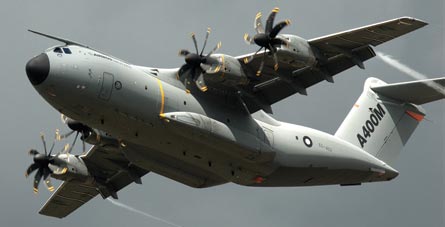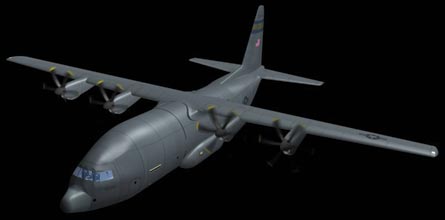Neil Smith has a tough assignment. For the next several years, the EADS North America director's task is to sell a European-built airlifter to a US military that now acknowledges no shortage of large transport aircraft.
Working under EADS NA vice-president for air force programmes Charles Coolidge, Smith's dogged sales job has been overshadowed in the past few years by the company's more high-profile pursuit of the prized US Air Force KC-X tanker contract.
|
|---|
But the US sales push for the Airbus Military A400M "Grizzly" is poised to become the company's primary opportunity for new business in the US market after the KC-X contract is awarded in November.
EADS believes the USAF has a hole in its airlift force structure wide enough to comfortably park an A400M. "There's a near-term gap," Smith says. "There's only one non-developmental solution that's going to be ready in time to fill that gap and it's the A400M."
EADS's corporate leaders have started laying the public foundations for an A400M sales campaign in the US market, with its chief executive Louis Gallois and North American chief executive Sean O'Keefe making the case for a future USAF purchase during the Farnborough air show in July. "The number of US defence officials who have requested to see the A400M at Farnborough is at record levels," O'Keefe said on the eve of the show.
|
|---|
AGGRESSIVE STRATEGY
The remarks are a preview of an aggressive strategy that will gain in momentum over the next 12 months. By early 2012, EADS plans to fly the A400M on a public tour of USAF and US Army bases, providing demonstration flights to pilots and logistics planners and featuring the Grizzly's advertised ability to land on short and rough fields.
Orchestrating the increasingly active EADS NA sales push is Smith, a former USAF logistics planner who managed the service's airlift mission during the Serbian air war in 1999. It was Smith's job to deliver supplies to the airport of Albania's capital Tirana, which became bogged down in an intractable layer of mud.
"The army was taking its vehicles and driving all over the ramps," Smith recalls. "That was a mud hole. Puddles mean nothing and mud means nothing [to military airlifters]. The aircraft go through mud on taxiways. The problem is mud dries, and mud becomes clumps."
Standing between Smith and a signed contract in the US market are several major barriers, not least of which is the USAF's stated determination to reduce its airlift fleet rather than expand with an all-new type.
"We are in an overcapacity situation, so retiring some [aircraft] because we don't need it is okay, but buying more so that we retire more is certainly not the way the department needs to be balancing its business in this airlift system," Alan Estevez, assistant deputy undersecretary of defence for supply chain integration, testified during a hearing on airlift by the Senate on 14 July.
In stark contrast to many global air forces, USAF officials are adamant that the service has too many airlifters. With 111 Lockheed Martin C-5s in inventory, 222 Boeing C-17s on order and up to 430 C-130s in the fleet, persuading the USAF to buy scores more airlifters seems one of Smith's most daunting challenges.
Another factor Smith must overcome is the perception of the A400M as a European-built platform. The outcome of the KC-X competition may expand or contract the limits of the US military's tolerance for equipment designed in another country. But proposing a new aircraft in a market with entrenched competition from US companies has proven problematic.
Finally, Smith faces the perception of the A400M as a poster child of a troubled aerospace development project. After the latest round of schedule delays and cost overruns, Smith's counterparts across the Atlantic Ocean are even now seeking to finalise a new contract with European governments buying A400Ms.
But Smith's sales campaign for the A400M has certain trends in its favour. The US government acknowledges the USAF's immense airlift fleet faces a critical capability gap. Last October, the Government Accountability Office issued a report on the airlift fleet that concludes the USAF is deficient in one area.
"There is a potential future gap in tactical airlift capabilities for transporting medium- weight army equipment that cannot fit on C-130 aircraft," GAO auditors wrote in a November 2009 report on the airlift fleet.
The USAF may have no shortage of airlifers, but does it have the right kind of aircraft?
|
|---|
EADS NA is not the only defence contractor that sees a need for something different in the USAF inventory. Both major aircraft suppliers to Air Mobility Command have unveiled new versions of airframes currently in production. Last year, Lockheed revealed a glimpse of the C-130XL, which widens the Hercules' cargo box that is now limited to just over 3m (9.9ft) across on the cargo ramp.
Boeing, meanwhile, proposed a C-17B advanced tactical airlifter several years ago, which adds a centreline landing gear and other changes to improve the aircraft's ability to land on the ground rather than a runway. In July, Boeing unveiled a variant of the C-17B proposal. The new concept narrows the C-17 airframe by about 1.3m, making it slightly wider, but still longer than the A400M.
|
|---|
TACTICAL AIRLIFT MISSION
The idea of a new aircraft for the tactical airlift mission has been around for decades. In the early 1970s, the end of the Vietnam War coincided with the USAF's failure to immediately launch production of a jet-powered, short-take-off-and-landing airlifter to replace the C-130E.
The prototypes of the Boeing YC-15 and McDonnell Douglas YC-14 were abandoned, although the latter's technology was later applied to the much larger C-17.
In the late 1980s, the USAF also pursued the advanced medium STOL transport (AMST), which was also cancelled. The USAF instead encouraged Lockheed to launch the C-130J, an improved version of the C-130 but retaining the same cargo box size introduced in 1954.
In the past decade, however, the US Army's ground mobility equipment has grown larger and wider. While the C-130 could squeeze in an up-armoured Humvee, the Hercules is unable to carry the new class of Stryker and mine-resistant ambush protection vehicles.
"So for a future airlifter you need something with payload and cargo-carrying dimensions to not only transport the thing, but to be able to deliver it directly to combat," Smith says. "You don't want to wait for [the vehicle's] slat armour to come on the next airplane."
The cross-section of the A400M cargo compartment is slightly more than 1m wider than the C-130. The A400M can also carry about twice the weight of the C-130. Its dimensions allow it to carry any military ground vehicle in the US Army inventory up to the size of a Bradley Fighting Vehicle, Smith says.
Smith thinks the nature of the tactical airlift mission is undergoing a fundamental change. It may no longer be enough to support ground forces using a network of bases centred on runways or even semi-prepared airfields, he says.
"It could be a road. It could be a field. So that's what they're looking for," Smith says. "And that makes you unpredictable. If I have lots of straight road, then I can change where I'm going. If I have a field and it's big I just keep landing on that, and once I eat that up [through repeated landings] I just move over 500ft and eat up that section."
That concept is actually the basis for a future airlifter concept on the drawing boards at Air Mobility Command. Called the Joint Future Theatre Lift (JFTL), the idea has been the subject of an internal debate. Some army officials say they need a vertical take-off capability, but the USAF has favoured an aircraft that can take off from an unimproved surface in 460m.
The USAF is preparing to launch an analysis of alternatives to lay the groundwork for launching a programme of record to develop and build a JFTL. But the timeline for producing an operational product is 15 years away, and will require billions of dollars of new investment even as military budgets are expected to contract. Smith believes that creates the perfect opening for the A400M, which is due to be ready for delivery to the USAF after 2015.
"It's a low-risk, non-developmental option for the United States. People are developing all kinds of stuff [to fill the same gap]. But they're all Powerpoint slides. We're no longer on Powerpoint slides, and we can't lie to you about its capabilities."
The key to Smith's sales pitch is one particular design feature. The A400M should be able to repeatedly land on a surface as soft and rough as a ploughed field, although that has not yet been validated in flight tests. The objective is to land on such a surface carrying a Stryker-sized vehicle. "It's flying what won't fit into a C-130 into places where a C-17 can't land," Smith says. "That's the gap."
Compared with the JFTL concept, the A400M needs nearly twice the distance to take off with a similar cargo load, but Smith thinks that can be set aside. "It may turn out that the [solution for the] near-term gap is good enough for the long term," he says. "If I'm runway independent, does it make any difference if I land in 2,800ft as opposed to 1,500ft? They haven't done the analysis to know that yet."
In February, Smith disclosed that EADS had submitted an unsolicited proposal to the USAF for 118 A400Ms, saying the entire acquisition cost could be financed with yearly operating savings generated from retiring the C-5A fleet and the oldest C-130Hs. A Lockheed executive criticised that strategy as "the ultimate in fuzzy math", noting that at the time EADS was not even publicly commenting on the final cost of the A400M programme.
In theory, the EADS proposal would address the USAF's concerns about growing an airlift fleet the service considers too large.
"AMC is going to have C-5s, C-17s and C-130Js for a long time," Smith says. "We're not telling them to throw that away. But you have a gap, and you have things operating in realms they don't do well in. So you're an inefficient fleet. If you add the A400M to the mix you not only fill the gap, you become more efficient."
Smith declines to comment on specifics about cost, saying the price would depend on quantity and the pace of deliveries. Some US contractors have recently offered fixed-priced deals on other contracts as the Department of Defense has grown more risk averse.
Could EADS offer a fixed-priced A400M deal? "I won't get into that," says Smith. "The original contract we had was a fixed-price contract. Let that be said. But we don't know."
EADS elaborates: "The requirement hasn't been formally developed. It's premature to come up with pricing for the US market."
Source: Flight International




















